Nikon Nikkor AF-S DX 16-80 mm f/2.8-4E ED VR
3. Build quality and image stabilization
In the photo below the tested lens is positioned next to the full frame Nikkor AF-S 24–70ámm f/2.8.
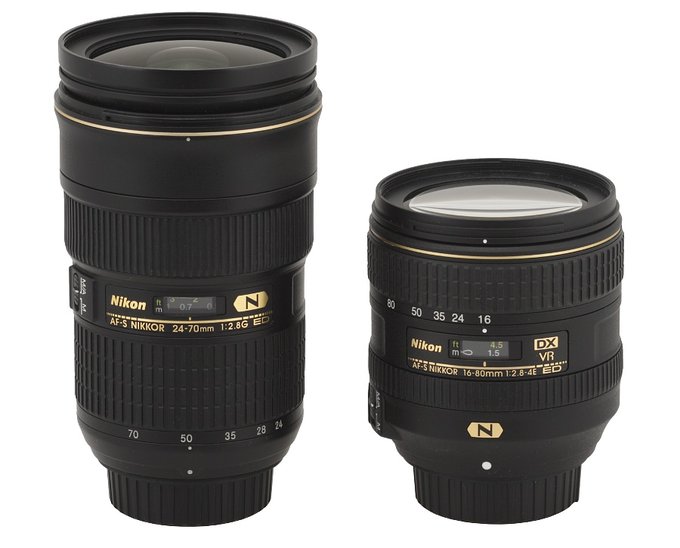 |
Please Support UsIf you enjoy our reviews and articles, and you want us to continue our work please, support our website by donating through PayPal. The funds are going to be used for paying our editorial team, renting servers, and equipping our testing studio; only that way we will be able to continue providing you interesting content for free. |
- - - - - - - - - - - - - - - - - - - - - - - - - - - - - - - - - - - - - - - - - - - - - - - -
The Nikkor AF-S DX 16–80ámm f/2.8–4E EDáVR starts with a metal mount which surrounds contacts and a rear element, 23 mm in diameter. At 16 mm the element is situated on the same level as the contacts and at 80 mm it hides inside the barrel about 2.5 cm deep. The interior of the tube is well darkened but in some places there are some slits through which electronic parts are visible.
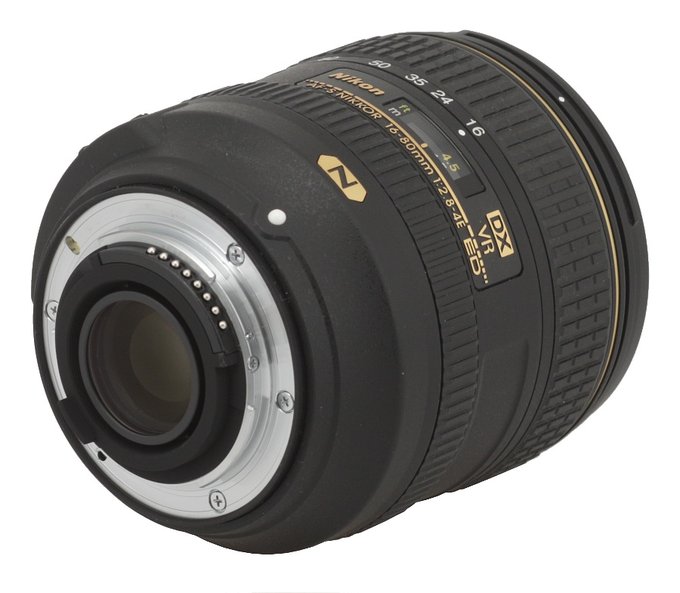 |
The proper body of the lens is covered by black plastic and starts with an immobile ring, increasing its diameter, with a white dot making an alignment with a camera easier. Above the dot you see the ‘N’ badge meaning the lens features Nano Crystal Coat and on the left there is an array of switches. The first one controls the focusing mechanism mode (M/A,M), the second one is responsible for the stabilization (VR ON/OFF), and the third allows you to choose its working mode (NORMAL/ACTIVE). On the side of the lens opposite to that “N” letter there is also a serial number of the instrument.
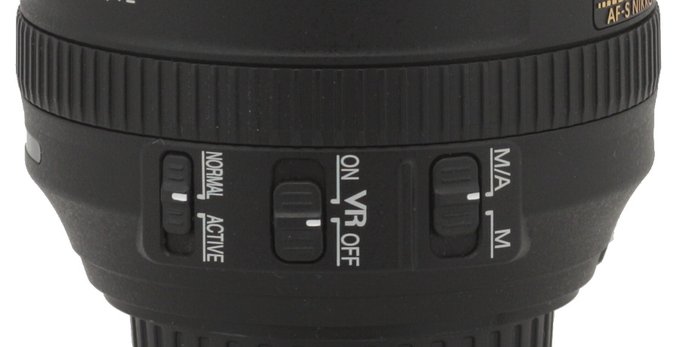 |
The next part you see is a manual focus ring. Unfortunately it works with a slack so characteristic for many Nikkor instruments. It often happens that you has to move the ring by the whole rib before you notice any change on the distance scale. I am still at a loss why Nikon has such a cavalier approach to such an important part of a not exactly cheap lens. The ring itself is as wide as 10 mm and running through the whole distance scale takes a turn through an angle of about 120 degrees.
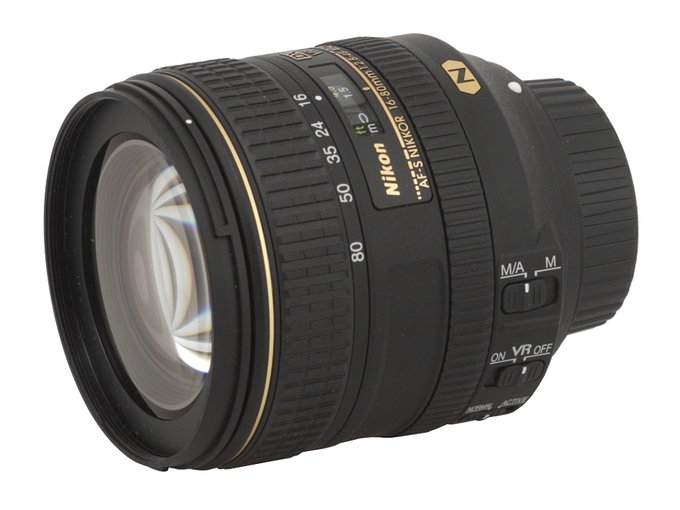 |
Further on there is a plate with a gold inscription stating the name and the parameters of the lens which goes round a window with a distance scale expressed in feet and meters. On the other side of the lens there is information that it was produced in Thailand with a list of technologies used in its production (e.g. Nano Crystal Coat, SWM, VR, ED, IF, Aspherical) and the filter’s diameter, amounting to 72 mm.
A zoom ring is the next part of the lens; it is as wide as 25 mm and most of its surface is covered by rubber ribbing. Above the ribbing you find a yellow stripe and below the stripe focal lengths markers at 16, 24, 35, 50 and 80 mm. The ring’s movements aren’t perfectly smooth.
The front element is slightly convex, with a diameter of 57 mm, surrounded by a non-rotating filter thread, 72 mm in diameter, and a hood mount. The whole front element system extends on a plastic, telescopic tube when you increase the focal length and the size of the lens increases by over 4 cm.
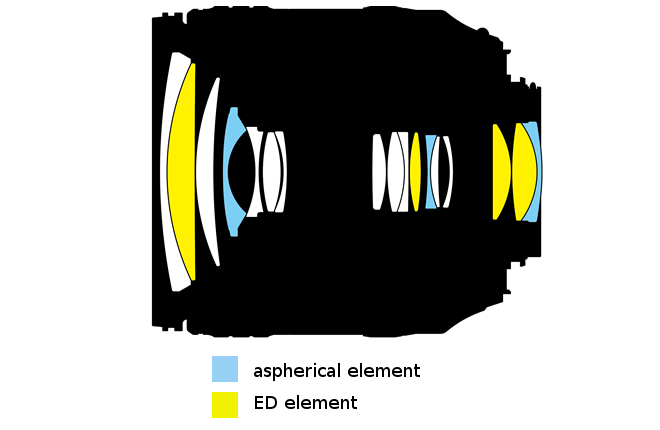
The optical construction of the tested Nikkor consists of as many as 17 elements positioned in 13 groups. Four elements are made of low dispersion ED glass and three others are aspherical. There is also an aperture with seven diaphragm blades which can be closed down to a value of f/22 at 16 mm and f/32 at 80 mm. The aperture is electromagnetic which means that the older Nikon reflex cameras (launched before 2007) won’t cooperate with it. It is also worth adding that the outer elements are covered by fluorine coat which are supposed to repel dust, water droplets, grease or dirt.
Buyers get both caps and a big hood in the box.
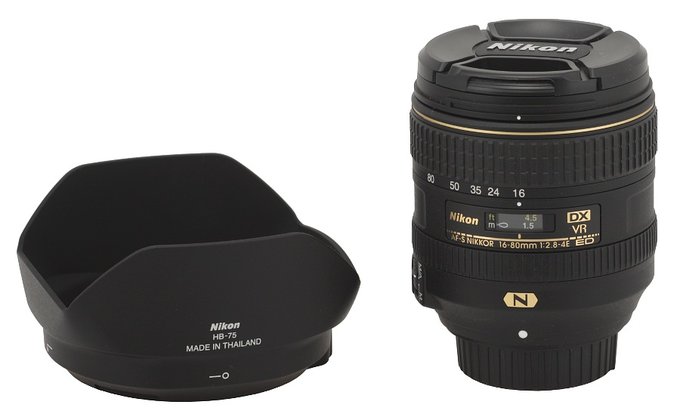 |
Optical stabilization
Nikon declares that the stabilization efficiency of the new Nikkor 16–80ámm amounts to 4 EV. In order to check that claim we took several dozen photos at the 80 mm focal length and our exposure times were ranging from 1/100 to 1/2 of a second with the stabilization unit switched on and off. For every series of shots we determined the percentage of blurred photos, presenting it as an exposure time function (with 0 EV is the equivalent of 1/125 of a second). An appropriate graph with the results is shown below.
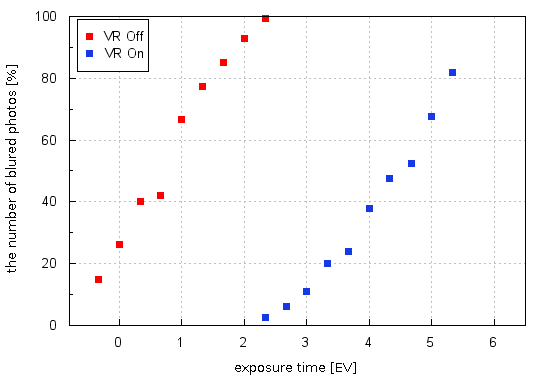
It is clear that the maximum distance between both curves reaches 4 EV and so we assess the efficiency of the stabilizing mechanism of the tested Nikkor. It is in perfect accordance with the declaration of the producer and such a result should be considered very good and indeed praise-worthy.






